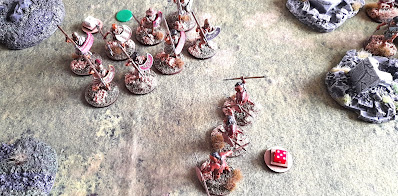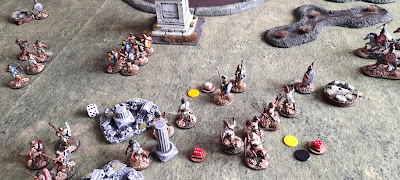CAN HEIRO THE HERO OF SYRACUSE STOP THE CARTHAGINIAN INVADERS FROM DESPOILING THE SACRED RESTING PLACE OF THE PYTHAGOREAN PHILOSOPHER, MAXIMOS MIASMA?
The year is 265BC and the island of Sicily is in a state of turmoil... the hounds of war have been let lose, roaming bands of marauding Mamertine mercenaries bring death and destruction throughout the land and Carthaginian warbands plunder and ransack wherever they roam.
Hamilcar Hathno is leading one such warband across the Pelagonian Plain towards the River Hypotenuse and the site of the Mausoleum of Maximos Miasma, the Corinthian philosopher and founding father of Syracuse, with the intention of defiling and looting the hallowed tomb.
Hurrying to defend Syracuse's most sacred shrine, Heiro the Hero, must, once more, risk all against the Carthaginian invaders and ensure that the resting place of his Corinthian ancestor remains untainted.
The forces probing towards the venerated vault are small detachments from the opposing armies; the Carthaginian force consists of the two leaders, a group of 8 Iberian Scutarii, 6 javelinmen, 6 slingers and 6 marauding Numidian light cavalry, while their opponents have two leaders, 6 veteran hoplites, 6 citizen hoplites, 8 peltatsts, 6 archers and 6 psiloi. The Syracusans have greater numbers, but the Carthaginians are slightly stronger in points value.
The Syracusan forces arrive on the field of glory, numerically superior but their command was not as good as the Carthaginians.
The battle from the Carthaginian side. The Carthaginian force was composed almost entirely of light troops, with only the Iberian Scutarii, equipped with the soliferrum, having any real melee capability.
The Carthaginians won the opening initiative roll, and their light troops began a desperate dash to reach the mausoleum before the more cumbersome Syracusan forces.
Heiro had placed his javelinmen and archers on his right and they hurriedly approached the Carthaginians in an attempt to disrupt their advance, giving the hoplites and peltasts time to defend the mausoleum.
In this stage of the action, Heiro's superior numbers proved to be a disadvantage, as there was insufficient room to allow them all to manoeuvre. The Syracusan commander placed his faith in his finest troops, sending his veteran hoplites forward to defend the mausoleum.
It looked for a time as though the Numidian horsemen would be first to reach the mausoleum, but Hamilcar knew he would need to get his Iberians there quickly to support the horsemen against the hoplites.
Meanwhile, Hamilcar's excellent Balearic slingers had reached the ruins south of the mausoleum and took up positions ready to repel the Syracusan javelinmen who were racing towards them.
In the exchange which followed, the slingers brought down the first casualties of the encounter, pushing themselves to the limit of their endurance to drive the enemy away from their position.
By the end of the first turn, the Carthaginians looked as though they had the upper hand, with the Balearic slingers and the Libyan javelinmen out numbering the Syracusan javelinmen. However, Heiro's archers had brought the advance of the Numidian cavalry to an abrupt halt, as they toppled one of the riders from his saddle and forced the Numidians to pull back out of range of the deadly arrows.
As turn two began, Hamilcar's Libyan javelinmen completed the rout of their Syracusan opposite numbers, presenting an opportunity for the Carthaginians to out flank their opponents.
The Syracusan veteran hoplites used their 'drilled' trait and the breathing space created by the archer's accurate fire, to advance in close order and take up position by the mausoleum. Realising that he may have missed his opportunity for victory, Hamilcar sent his Numidians into action once more, where they repeatedly hurled javelins at the hoplites before turning away to prepare for another assault.
As the hoplites stood and defended themselves from the relentless hail of Numidian missiles, Hamilcar's Iberian Scutarii arrived, increasing the pressure on the hoplites by hurling their soliferums into their massed ranks.
The brave hoplites held firm, however, and neither the Iberians nor the Numidians were prepared to risk trading blows with them until their formation could be broken.
Sensing the threat to his right flank, Heiro hurriedly sent his peltasts to engage the Balearic slingers and the Libyan javelinmen, who immediately began to suffer from the accurate fire of the Syracusan missiles.
The Iberian Scutarii took the opportunity afforded by the stand-off at the mausoleum to replenish their soliferums, which they launched at the hoplites, causing two casualties. Realising that support was still some distance away, the hoplites threw caution to the wind and launched an attack against the Iberians.
The melee between the hoplites and the Scutarii became a grinding match, with the Iberians being relentlessly pushed back.
Yet again, the Numidian cavalry rode into the fray, hurling more javelins into the hoplite ranks and eventually causing them to break ranks.
At this stage in the action, the Iberians were too exhausted to take advantage of the hoplite's desperate situation and, with the Heiro's Citizen Hoplites finally arriving to defend the mausoleum, Hamilcar knew he had nothing left to commit to the battle.
Reluctantly, the Carthaginian commander signalled for his remaining forces to withdraw, leaving the mausoleum of Maximos Miasma in the hands of the triumphant Syracusans.
There were several thought-provoking aspects which arose during the course of this encounter; firstly, was the situation the Iberian Scutarii found themselves in facing the Veteran Hoplites. The Iberians' soliferums had little impact on the hoplites in their close order formation and they couldn't afford to attack them because of the hoplite's 'Wall of Spears' trait. Secondly, the Numidian cavalry were kept at bay by missile fire from the Syracusan archers, but, once the archers were no longer able to target them, they were able to have an impact on the action between the hoplites and the scutarii. Thirdly, was the difference that having a shield of some kind makes to light infantry, such as the Libyan javelinmen in the Carthaginian warband, compared to those without, such as the javelinmen in the Syracusan warband.
As usual, Clash of Spears continues to be a really exciting and entertaining game which really challenges the little grey cells and keeps you totally involved throughout, regardless of whose activation it is.























No comments:
Post a Comment